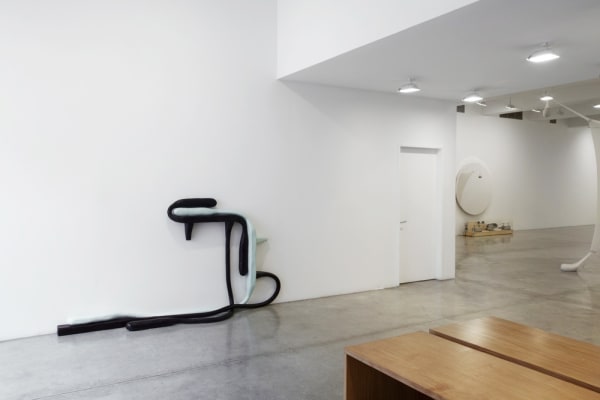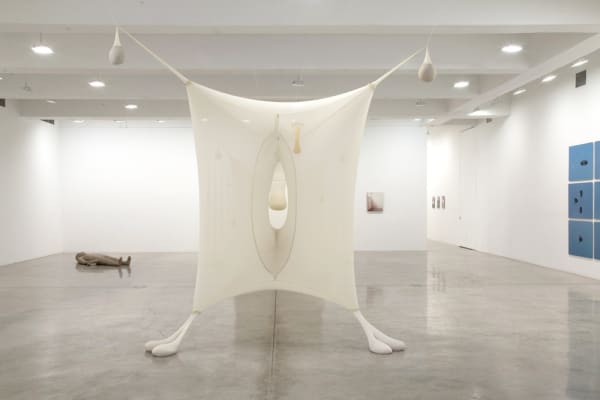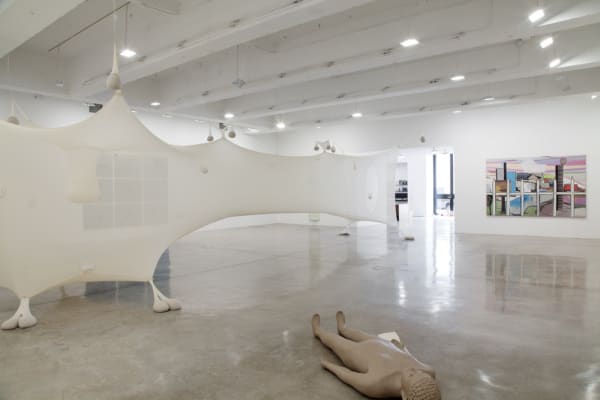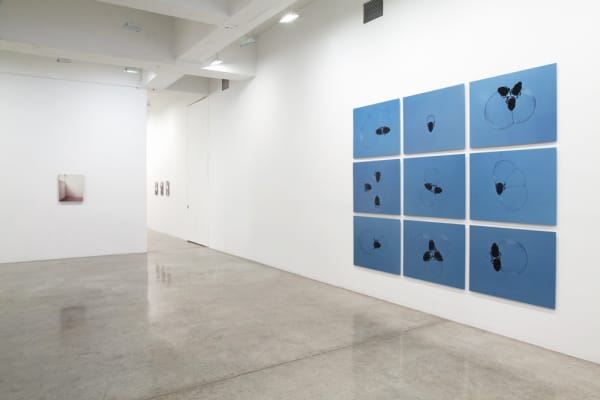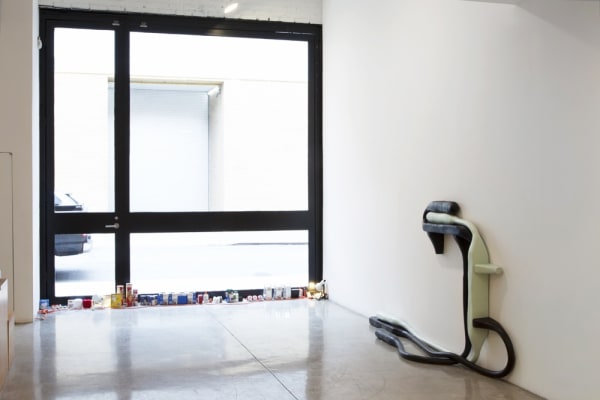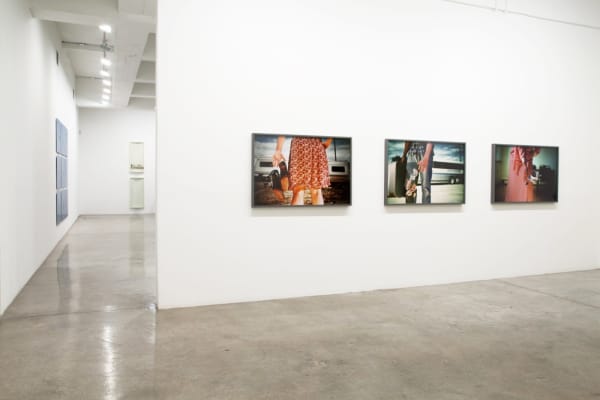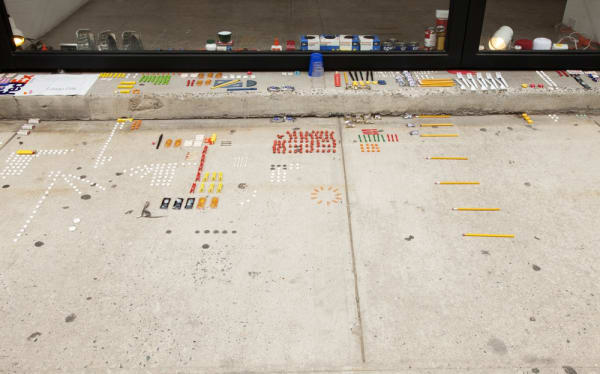The Bigger Picture: Tanya Bonakdar Gallery, New York
Tanya Bonakdar Gallery is very pleased to celebrate its twentieth anniversary with a group exhibition highlighting important historical works by gallery artists. Taking its title from a wall text piece made by Haim Steinbach, the presentation brings together key sculptures, films, paintings, photographs and installations from the gallery’s early years that together reflect the depth of the program as well as the practices of many influential artists who have helped shape it throughout the past two decades.
From iconic photo series to early sculpture and large-scale installation, the works included in this presentation represent the foundations or conceptual departure points that have defined practices and broader dialogues in contemporary art since the 1990s. Starting outside the building on the front sidewalk, and then continuing on the inside of the gallery's large front window, Sarah Sze's sprawling installation Untitled (Thessaloniki) from 1997 addresses notions of value, our daily rituals, and the way that everyday objects define space and are markers for behavior. Featuring a minutely-detailed landscape of candies, bungee cords, canned food, and other recognizable objects, this work is among the artist's first major installations, created while Sze was still in graduate school. Also near the entrance of the gallery is an early rubber shelf work by Charles Long titled A Life. This work is from a series begun in the mid-1990s that challenges the boundaries between abstraction and figuration, while simultaneously playing out a scenario of support, dependence, superfluousness and abandonment.
In Gallery 1, Ernesto Neto's iconic sculptural installation, Flying Gloup Nave (Nave Voadora), a gauzy, biomorphic installation made from nylon stocking, styrofoam beads and sand, functions as a vast, suspended enclosure that serves as both sculpture and architecture. The womb-like shape is suggestive of the hull of a ship or a living organism, while the title refers to both the nave of a cathedral, and a word that means "ship" or "capsule" in Portuguese. Olafur Eliasson’s Convex/concave (1995-2000), a hydraulic-powered mirror sculpture demonstrating the artist’s early experiments with modes of perception and spatial experiences is also on view downstairs. Distorting reflections through a gradually expanding and contracting foil surface, this work reorients perceptions of space to project new ways of seeing and engaging with the world. Brazilian artist Sandra Cinto pushes the formal boundaries of drawing by incorporating different media and a rich repertoire of imagery into intricate, dream-like compositions. Here, a photographic diptych featuring a self-portrait of the artist sleeping, framed beneath hand-etched glass, is a beautiful example of her early work featuring wistful landscapes of spindly trees, ladders, and swings. Taking its title from a group reasoning exercise in mathematics, Rivane Neuenschwander's series of photographs reflects the artist's early investigations of chance and control as they relate to the natural world. A grid of nine photographs document the various possible combinations between three beetles and three soap bubbles according to mathematical theory, exploring poetic narratives of collaboration, chance, and temporality in the incidental, everyday phenomena that is frequently overlooked.
For more than twenty years, Mark Manders has developed an endless self-portrait that has taken the forms of sculpture, still life, and architectural plans. Among his first sculptural investigations of form, meaning and narrative, a clay figure combines many stylistic characteristics adopted from various cultures- Greek Etruscan, Egyptian, African and Asian, as the artist investigates philosophies of time, location, and biography. Nearby Thomas Scheibitz's Casting, a beautiful large-scale painting of a landscape in a palette of bright blue, gray and white with accents of red, purple, and green, is a lovely example of how the artist pares down the recognizable image to its barest formal properties, then expands upon it, bridging the line between abstraction and figuration.
Also in the downstairs gallery space, Uta Barth's photograph from her early Ground series demonstrates the beginnings of the artist's investigations of the world in our periphery and the nature of vision. Nearby, Hubbard & Birchler's series Falling Down explores the physical world, but also the psychological relationships between space, architecture, character and object. Two pieces by Gillian Wearing are also presented in the back gallery, including iconic photos from the series Signs that say what you want them to say and not Signs that say what someone else wants you to say (1992-3). In addition, in a small dark chamber not unlike a religious confessional box, one masked figure after another recounts intimately kept personal secrets in a 30 minute video titled Confess All On Video. This work is a forerunner to fly-on-the-wall documentaries and points to the public's growing desire for personal confession and voyeurism.
Moving upstairs, one of Susan Philipsz's most well-known works is presented in the gallery stairwell. Exploring the psychological and spatial properties of sound, The Internationale features a recording of the artist singing the socialist anthem without musical accompaniment. Philipsz transforms this historic call to action into a lullaby or elegy-like composition that slowly permeates the space it fills, or rather, seemingly haunts. At the entrance to Gallery 2, viewers encounter Olafur Eliasson's Your Compound Eye, the artist's first kaleidoscope and among his earliest experiments with modes of perception relating to space, time, and movement. Made from six tapering mirrored panels fixed together in a hexagonal shape, the sculpture allows for a significantly larger view angle than that of the human eye. Challenging the limits of perception, the work invites viewers to experience each other and the space in numerous, shifting, fractal reflections.
In the gallery's project room, Phil Collins' video how to make a refugee is on view. A pivotal work, and one of Collins' earliest videos, the piece depicts a Kosovar boy who has been wounded, here posed by a photographer and interviewed by a journalist. The work's title makes reference to the media, not the warlords, military, or government officials who are the ones making representations of refugees for mass consumption. Also included upstairs in Gallery 2 is a large-scale structural piece by Haim Steinbach titled Backyard Story (1997). Furthering his early investigations of display as a way of contextualizing objects and reorienting space, this work features plastic jack-o’-lanterns, Weber grills, chopped logs and articles of clothing strung along a washing line, all carefully arranged within industrial shelving units.
Martin Boyce's Now I've Got Worry (Mask and L-Bar), is shaped like a plywood leg splint designed by Charles and Ray Eames in 1942-3 and a metal bar from an Eames-designed storage unit. Here, Boyce suggests the cycles and history of visual culture, specifically how the forms of Modernism have inspired decades of design and the urban landscape. Mat Collishaw's classic sculpture Dog's Breath from 1992 is an excellent early example of work by this YBA artist that recontextualizes the impact of traditionally sinister subject matter. A continuous audio loop of a dog snarling is tense and disturbing, even sexually suggestive. Yet over the course of several minutes the dog's growls transform from a disturbing threat to numb, repetitive noise, as the viewer is inoculated to its sound. Lastly, Mark Dion's Concrete Jungle (Mammalia) poses a scene of the natural world in transformation. Part of a larger series from the early 1990s, this piece is focused on city mammals, as a cat, opossum, raccoon, rat, squirrel and mice meet unexpectedly one night in an urban trash area. This sculpture, like so many other works by Dion, investigates what happens to animals as they adapt to and thrive in our newly developed urban ecosystems, and when human environments intersect with nature.
All installation images above: Photo by Jean Vong
